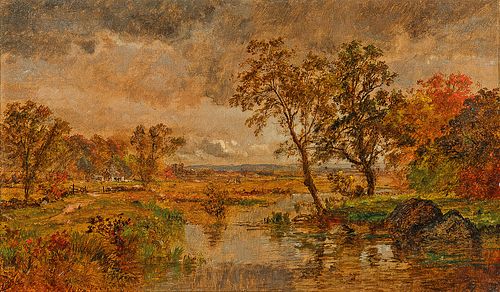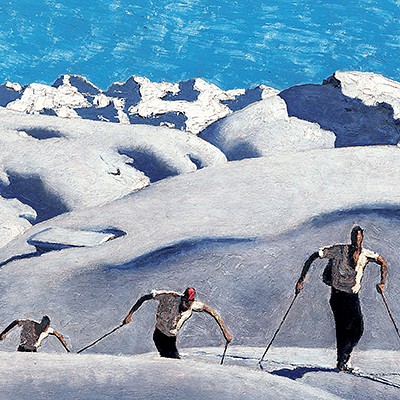Jasper Francis Cropsey (American, 1823-1900) Landscape
Lot 241
About Seller
Bonhams Skinner
274 Cedar Hill Street
Marlborough, MA 01752
United States
Founded over four decades ago, Bonhams Skinner offers more than 60 auctions annually. Bonhams Skinner auctions reach an international audience and showcase the unique, rare, and beautiful in dozens of categories, including the fine and decorative arts, jewelry, modern design, musical instruments, sc...Read more
Estimate:
$15,000 - $25,000
Absentee vs Live bid
Two ways to bid:
- Leave a max absentee bid and the platform will bid on your behalf up to your maximum bid during the live auction.
- Bid live during the auction and your bids will be submitted real-time to the auctioneer.
Bid Increments
| Price | Bid Increment |
|---|---|
| $0 | $10 |
| $100 | $25 |
| $500 | $50 |
| $1,000 | $100 |
| $3,000 | $250 |
| $5,000 | $500 |
| $10,000 | $1,000 |
| $30,000 | $2,500 |
| $50,000 | $5,000 |
| $100,000 | $10,000 |
| $300,000 | $25,000 |
| $500,000 | $50,000 |
| $1,000,000 | $100,000 |
About Auction
By Bonhams Skinner
May 31, 2020
Set Reminder
2020-05-31 12:00:00
2020-05-31 12:00:00
America/New_York
Bidsquare
Bidsquare : Fine Paintings & Sculpture
https://www.bidsquare.com/auctions/skinner/fine-paintings-sculpture-5137
This auction covers a broad range of Western styles, media, and regions from the 16th century to the present day including paintings, sculpture, and works on paper Bonhams Skinner bidsquare@bonhamsskinner.com
This auction covers a broad range of Western styles, media, and regions from the 16th century to the present day including paintings, sculpture, and works on paper Bonhams Skinner bidsquare@bonhamsskinner.com
- Lot Description
Jasper Francis Cropsey (American, 1823-1900)
Landscape
Signed and dated "J.F. Cropsey/1889" l.l.
Oil on canvas, 12 x 20 in. (30.5 x 50.8 cm), framed.
Condition: Lined, retouch, very fine, stable craquelure.
Provenance: Descended within a private Massachusetts collection.
Literature: Anthony M. Speiser, et al., Jasper Francis Cropsey: Catalogue Raisonné (Newington-Cropsey Foundation: Hastings-on-Hudson, NY), 2013, volume III, p. 69, entry 2002 (not illustrated).
N.B. One of the leading artists of the Hudson River School, Jasper Francis Cropsey first started to paint in and around the Hudson River Valley in the 1850s. From childhood, Cropsey showed both interest and ability in drawing, and taught himself by copying the paintings and drawings of established artists. Although he initially trained as an architect, Cropsey had early success as a landscape painter. Cropsey was greatly influenced by the work of Thomas Cole and developed a palette and romantic sensibility akin to the older artist's style. He is best known for his autumnal views; sunlit scenes filled with the vibrant colors that are ubiquitous in fall throughout New York and New England.
Cropsey moved to his home, "Ever Rest," overlooking the ravine at Hasting-on-Hudson in 1885. Here he lived more simply than he had as a younger man, focusing largely on the scenic views of his immediate surroundings, although he also created landscapes based on his vast number of sketches from his earlier travels. The present view is probably from the vicinity of Warwick, New York, not far west of "Ever Rest."
A copy of correspondence from the Newington-Cropsey Foundation, dated September 9, 2013, accompanies the lot.
Estimate $15,000-25,000
The work has been professionally restored. There is retouch in a V-shape in the center of the composition, extending from the shadow in the foreground pond diagonally upwards on each side into the nearest trees. The "arms" of the V are about 5-1/2 to 6 inches each side. There are also two curved dark lines in the sky that may be underdrawing.
Items may have wear and tear, imperfections, or the effects of aging. Any condition statement given, as a courtesy to a client, is only an opinion and should not be treated as a statement of fact. Skinner shall have no responsibility for any error or omission. - Shipping Info
-
Please visit http://www.skinnerinc.com/services/payment-and-shipping/ for information regarding the collection of items purchased at auction.
-
- Buyer's Premium



 EUR
EUR CAD
CAD AUD
AUD GBP
GBP MXN
MXN HKD
HKD CNY
CNY MYR
MYR SEK
SEK SGD
SGD CHF
CHF THB
THB


















